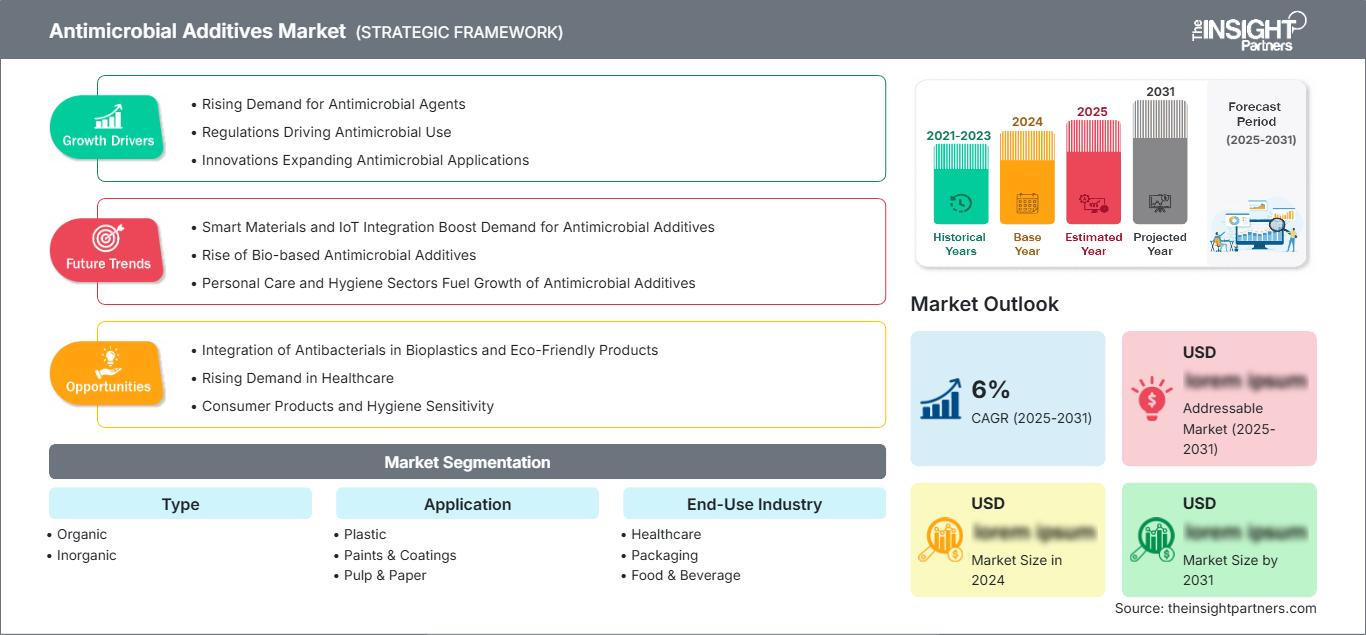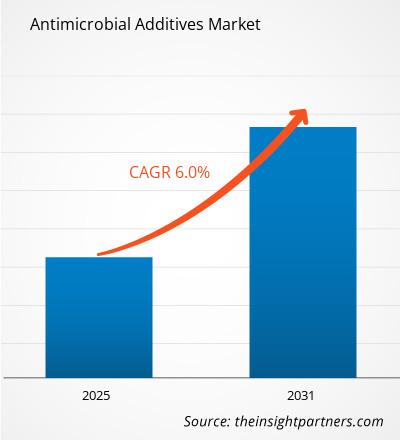Der Markt für antimikrobielle Additive wird bis 2031 voraussichtlich ein Volumen von 6,72 Milliarden US-Dollar erreichen. Für den Zeitraum 2025–2031 wird ein jährliches Wachstum von 7,7 % erwartet.
Der Bericht ist nach Typ (organisch, anorganisch) segmentiert. Die globale Analyse wird weiter auf regionaler Ebene und für wichtige Länder aufgeschlüsselt. Der Bericht präsentiert außerdem eine Analyse basierend auf der Anwendung (Kunststoffe, Farben & Lacke, Zellstoff & Papier, Sonstige). Auch diese globale Analyse wird weiter auf regionaler Ebene und für wichtige Länder aufgeschlüsselt. Marktgröße und Prognosen auf globaler, regionaler und Länderebene für alle wichtigen Marktsegmente sind im Bericht enthalten. Die Werte für die oben genannten Analysen und Segmente werden in US-Dollar angegeben. Der Bericht liefert wichtige Statistiken zum Marktstatus der wichtigsten Marktteilnehmer und zeigt Markttrends und -chancen auf. Ziel des Berichts ist es, die aktuelle Marktlage und das zukünftige Wachstum, die wichtigsten Triebkräfte, Herausforderungen und Chancen zu beschreiben. Dies wird verschiedenen Akteuren im Geschäftsbereich Einblicke ermöglichen, wie beispielsweise:
- Technologieanbieter/Hersteller: Um die sich entwickelnde Marktdynamik zu verstehen und potenzielle Wachstumschancen zu erkennen, können sie fundierte strategische Entscheidungen treffen.
- Investoren: Um eine umfassende Trendanalyse hinsichtlich Marktwachstumsrate, Finanzprognosen und Chancen entlang der Wertschöpfungskette durchzuführen.
- Regulierungsbehörden: Um Richtlinien zu regulieren und Aktivitäten auf dem Markt zu überwachen, mit dem Ziel, Missbrauch zu minimieren, das Vertrauen der Anleger zu wahren und die Integrität und Stabilität des Marktes zu gewährleisten. Marktsegmentierung für antimikrobielle Additive: Typ
- Organisch
- Anorganisch
Anwendung
- Kunststoffe
- Farben & Lacke
- Zellstoff & Papier
- Sonstige
Endverbrauchsbranche
- Gesundheitswesen
- Verpackung
- Lebensmittel & Getränke
- Bauwesen
- Automobilindustrie
- Sonstige
Geografie
- Nordamerika
- Europa
- Asien-Pazifik
- Süd- und Mittelamerika
- Naher Osten und Afrika
Passen Sie diesen Bericht Ihren Anforderungen anSie erhalten kostenlos Anpassungen an jedem Bericht, einschließlich Teilen dieses Berichts oder einer Analyse auf Länderebene, eines Excel-Datenpakets sowie tolle Angebote und Rabatte für Start-ups und Universitäten.
Markt für antimikrobielle Zusatzstoffe: Strategische Einblicke

-
Holen Sie sich die wichtigsten Markttrends aus diesem Bericht.Dieses KOSTENLOSE Beispiel umfasst Datenanalysen, die von Markttrends bis hin zu Schätzungen und Prognosen reichen.
Wachstumstreiber für den Markt antimikrobieller Additive
- Steigende Nachfrage nach antimikrobiellen Wirkstoffen: Die zunehmende Hysterie um Hygiene und Gesundheit, insbesondere in Zeiten der COVID-19-Pandemie, hat die Verwendung antimikrobieller Wirkstoffe in der modernen Bevölkerung deutlich begünstigt. Diese Additive finden immer häufiger Anwendung in Alltagsgegenständen wie Kleidung, Lebensmittel- und Getränkebehältern, medizinischen Geräten und Elektrogeräten, um das Wachstum und die Ausbreitung von Mikroorganismen zu kontrollieren und so die Haltbarkeit und Sicherheit der Produkte zu erhöhen.
- Regulatorische Vorgaben fördern den Einsatz antimikrobieller Mittel: Weltweit werden die Vorschriften zur Produktsicherheit, insbesondere im Bereich der Medizin- und Lebensmittelverpackungen, verschärft. Daher sind Hersteller gezwungen, antimikrobielle Inhaltsstoffe in ihren Produkten zu verwenden, um die Hygiene- und Sicherheitsanforderungen zu erfüllen. Dies gilt insbesondere für Branchen wie das Gesundheitswesen und die Lebensmittelverpackung, in denen Verbraucher vor schädlichen Mikroorganismen geschützt werden müssen. Innovationen erweitern antimikrobielle Anwendungen: Die Herstellung neuerer und verbesserter antimikrobieller Additive mit deutlich längerer Wirkungsdauer hat deren Einsatz in weiteren Bereichen wie dem Bauwesen ermöglicht. Dies wird durch die verbesserte Wirksamkeit bei der Kontrolle und Verhinderung des Wachstums von Mikroorganismen, den Einsatz neuer Technologien wie der Nanotechnologie und das Wachstum dieser Märkte in Branchen wie der Textil-, Bau- und Fahrzeugindustrie vorangetrieben. Zukunftstrends des Marktes für antimikrobielle Additive: Intelligente Materialien und IoT-Integration steigern die Nachfrage nach antimikrobiellen Additiven: Mit dem Aufkommen intelligenter Materialien und ihrer Kommunikationstechnologie werden antimikrobielle Additive immer häufiger in Produkten wie Wearables, intelligenten Verpackungen und Medizinprodukten eingesetzt. Diese Additive werden voraussichtlich über die reine antimikrobielle Wirkung hinausgehen und Funktionen wie die Echtzeitüberwachung des Hygienestandards bieten, wodurch die Funktionalität und Sicherheit von IoT-Geräten verbessert werden.
- Aufstieg biobasierter antimikrobieller Additive: Der Fokus hat sich hin zur Verwendung natürlicherer Materialquellen wie Pflanzenextrakten und ätherischen Ölen verlagert. Aufgrund des Drucks von Markt und Behörden, umweltfreundliche Alternativen bereitzustellen, ist ein deutlicher Anstieg des Einsatzes biobasierter antimikrobieller Additive zu verzeichnen. Diese biobasierten Additive sind nicht nur umweltfreundlich, sondern tragen auch zur Abfallreduzierung bei, da sie biologisch abbaubar sind und somit den aktuellen Trend zu umweltverträglichen Komponenten unterstützen.
- Körperpflege- und Hygienebranche treibt Wachstum antimikrobieller Additive an: Die Märkte für Körperpflege und Hygiene werden sich im Prognosezeitraum voraussichtlich als starke Wachstumstreiber für antimikrobielle Additive erweisen. Da Verbraucher Produkte mit erhöhtem Schutz vor Bakterien und Viren suchen, wird der Einsatz antimikrobieller Additive in Produkten wie Kosmetika, Hautpflegeprodukten und Desinfektionsmitteln weiter zunehmen. Dies wird durch die Nachfrage der Verbraucher und die Notwendigkeit, Krankheiten einzudämmen, insbesondere nach dem Ausbruch von COVID-19, vorangetrieben.
Marktchancen für antimikrobielle Additive
- Integration von antibakteriellen Wirkstoffen in Biokunststoffe und umweltfreundliche Produkte: Aufgrund der wachsenden Besorgnis über Umweltauswirkungen besteht ein hohes Potenzial für die Anwendung von antibakteriellen Wirkstoffen in Biokunststoffen und anderen umweltfreundlichen Schutzmitteln. Die Verwendung biomedizinischer Kunststoffe bei der Herstellung von Produkten wie Verpackungen und Textilien, die sich eindeutig in Richtung Nachhaltigkeit entwickeln, wird den Einsatz antimikrobieller Additive, die diesen umweltfreundlichen Materialien beigemischt werden können, unaufhaltsam beeinflussen. Dies könnte insbesondere Regionen betreffen, die sich der Umweltprinzipien bewusst sind, auch wenn sie diese in ihren Aktivitäten nicht vollständig umsetzen.
- Steigende Nachfrage im Gesundheitswesen: Das Gesundheitswesen stellt aufgrund des steigenden Bedarfs an Schutz für medizinische Geräte und der Reduzierung von Krankenhausinfektionen einen bedeutenden Markt für antimikrobielle Additive dar. Die zunehmenden Sicherheitsbedenken von Patienten und medizinischem Fachpersonal werden den Einsatz antimikrobieller Zusätze in Produkten und Geräten wie Kathetern, Implantaten und chirurgischen Instrumenten vorantreiben und den Markt im medizinischen Bereich weiter ausdehnen.
- Konsumgüter und Hygienebewusstsein: Antimikrobielle Wirkstoffe sind bereits in einigen Konsumgütern wie Küchen- und Elektrogeräten sowie Textilien enthalten. Da Kunden vermehrt hygienische Produkte nachfragen, werden antimikrobielle Substanzen künftig auch in Produkten wie Zahnbürsten, Mobiltelefonen und Bettwäsche eingesetzt. Die steigende Nachfrage der Verbraucher nach Hygiene in Verbindung mit einem wachsenden Bewusstsein für die Notwendigkeit antimikrobiellen Schutzes wird zahlreiche Wachstumschancen eröffnen.
Markt für antimikrobielle Zusatzstoffe
Die regionalen Trends und Einflussfaktoren auf den Markt für antimikrobielle Zusatzstoffe im gesamten Prognosezeitraum wurden von den Analysten von The Insight Partners ausführlich erläutert. Dieser Abschnitt behandelt außerdem die Marktsegmente und die geografische Verteilung des Marktes für das Management von Herzrhythmusstörungen in Nordamerika, Europa, Asien-Pazifik, dem Nahen Osten und Afrika sowie Süd- und Mittelamerika.
Berichtsumfang zum Markt für antimikrobielle Zusatzstoffe
By Anwendung- Kunststoff
- Farben und Beschichtungen
- Zellstoff und Papier
- Sonstiges
- Gesundheitswesen
- Verpackung
- Lebensmittel und Getränke
- Bauwesen
- Automobilindustrie
- Sonstige
- Nordamerika
- Europa
- Asien-Pazifik
- Süd- und Mittelamerika
- Naher Osten und Afrika
- Großbritannien
- Deutschland
- Frankreich
- Russland
- Italien
- Restliches Europa
- China
- Indien
- Japan
- Australien
- Restlicher Asien-Pazifik
- Brasilien
- Argentinien
- Restliches Süd- und Mittelamerika
- Südafrika
- Saudi-Arabien
- Vereinigte Arabische Emirate
- Restlicher Naher Osten und Afrika
Berichtsattribut Einzelheiten Marktgröße in 2024 US$ XX Billion Marktgröße nach 2031 US$ 6.72 Billion Globale CAGR (2025 - 2031) 7.7% Historische Daten 2021-2023 Prognosezeitraum 2025-2031 Abgedeckte Segmente By Typ - Organisch
- Anorganisch
Abgedeckte Regionen und Länder Nordamerika - USA
- Kanada
- Mexiko
Marktführer und wichtige Unternehmensprofile - BASF SE
- Nutrition & Biosciences
- Microban International
- LyondellBasell Industries Holdings B.V.
- Avient
- BioCote Limited
- Novapura AG
- Clariant
- Americhem
Dichte der Marktteilnehmer im Bereich antimikrobieller Zusatzstoffe: Auswirkungen auf die Geschäftsdynamik
Der Markt für antimikrobielle Zusatzstoffe wächst rasant, angetrieben durch die steigende Nachfrage der Endverbraucher. Gründe hierfür sind unter anderem sich wandelnde Verbraucherpräferenzen, technologische Fortschritte und ein wachsendes Bewusstsein für die Vorteile des Produkts. Mit steigender Nachfrage erweitern Unternehmen ihr Angebot, entwickeln innovative Lösungen, um den Verbraucherbedürfnissen gerecht zu werden, und nutzen neue Trends, was das Marktwachstum zusätzlich beflügelt.

- Holen Sie sich die Markt für antimikrobielle Zusatzstoffe Übersicht der wichtigsten Akteure
Wichtigste Verkaufsargumente
- Umfassende Abdeckung: Der Bericht bietet eine umfassende Analyse der Produkte, Dienstleistungen, Typen und Endnutzer des Marktes für antimikrobielle Additive und vermittelt so ein ganzheitliches Bild.
- Expertenanalyse: Der Bericht basiert auf dem fundierten Wissen von Branchenexperten und Analysten.
- Aktuelle Informationen: Der Bericht gewährleistet Geschäftsrelevanz durch die Berücksichtigung aktueller Informationen und Datentrends.
- Anpassungsmöglichkeiten: Dieser Bericht kann an spezifische Kundenanforderungen angepasst werden und sich optimal in die Geschäftsstrategien integrieren.
Der Forschungsbericht zum Markt für antimikrobielle Additive kann somit maßgeblich dazu beitragen, das Branchenszenario und die Wachstumsaussichten zu entschlüsseln und zu verstehen. Auch wenn einige berechtigte Bedenken bestehen, überwiegen die Vorteile dieses Berichts insgesamt die Nachteile.
- Historische Analyse (2 Jahre), Basisjahr, Prognose (7 Jahre) mit CAGR
- PEST- und SWOT-Analyse
- Marktgröße Wert/Volumen – Global, Regional, Land
- Branchen- und Wettbewerbslandschaft
- Excel-Datensatz
Aktuelle Berichte
Verwandte Berichte
Erfahrungsberichte
Grund zum Kauf
- Fundierte Entscheidungsfindung
- Marktdynamik verstehen
- Wettbewerbsanalyse
- Kundeneinblicke
- Marktprognosen
- Risikominimierung
- Strategische Planung
- Investitionsbegründung
- Identifizierung neuer Märkte
- Verbesserung von Marketingstrategien
- Steigerung der Betriebseffizienz
- Anpassung an regulatorische Trends






















 Kostenlose Probe anfordern für - Markt für antimikrobielle Zusatzstoffe
Kostenlose Probe anfordern für - Markt für antimikrobielle Zusatzstoffe